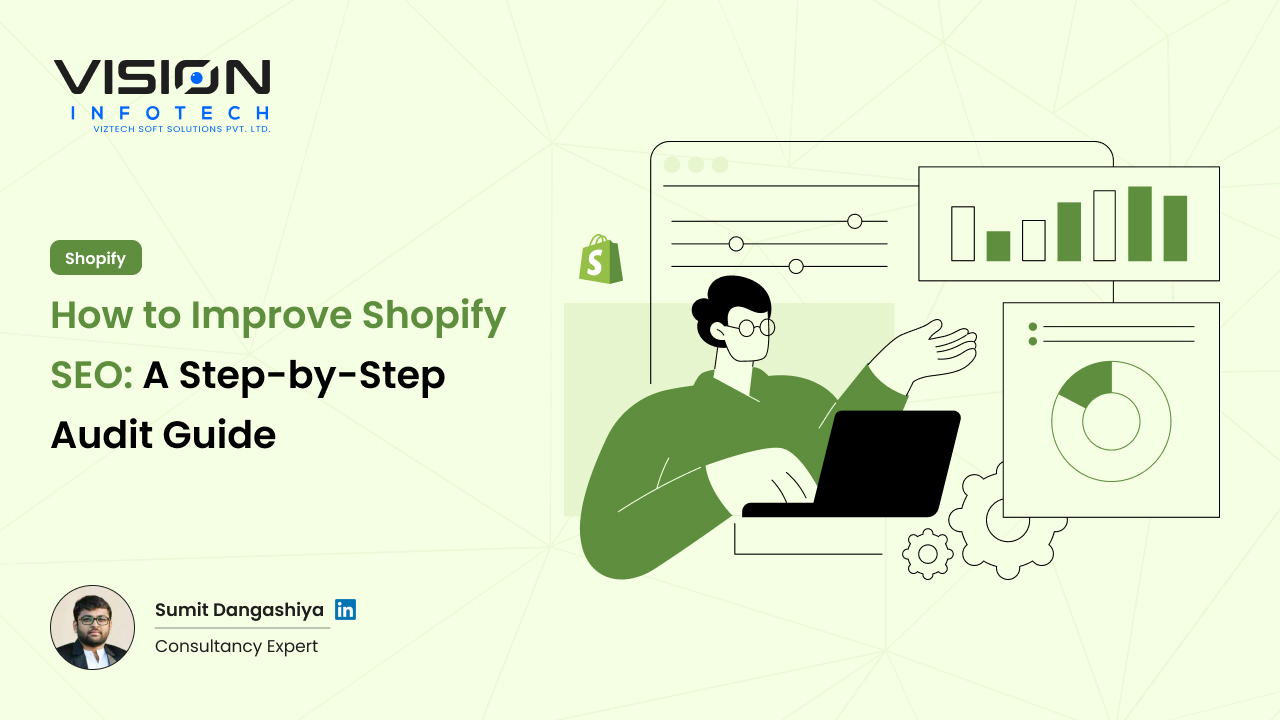Blog
Our blog offers a window into the world of Vision Infotech, where we share expert advice, industry trends, and success stories. Stay informed and inspired with our latest posts.

How to Improve Shopify SEO: A Step-by-Step Audit Guide

Sumit Dangasiya
April 2, 2025Hi, I’m Sumit Dangashiya, a consultancy expert from Vision Infotech. If you’re running a Shopify store and want to generate more leads from your website, improving your Shopify SEO (Search Engine Optimization) is one of the best ways to do it. SEO helps your store show up higher on Google when people search for products you sell. More visibility means more visitors, and more visitors can turn into leads and sales. Today, I’ll walk you through a simple, step-by-step audit guide to boost your Shopify SEO. Let’s make it easy and practical so you can start seeing results.
Step 1: Understand Why SEO Matters for Your Shopify Store
SEO is like a free tool to bring people to your website without paying for ads all the time. When someone searches “buy trendy clothes online” or “best phone cases,” you want your Shopify store to appear on the first page of Google. If it’s buried on page 5, no one will find you. A good SEO audit checks what’s working and what’s not, so you can fix it and get more leads. At Vision Infotech, we’ve helped many businesses climb Google rankings, and I’ll share the same tricks with you.
Step 2: Check Your Website Speed
First things first—how fast does your Shopify store load? If it takes too long, visitors will leave before they even see your products. Google also likes fast websites and ranks them higher. To check your speed, use a free tool like Google PageSpeed Insights. Just type in your website URL and hit enter. It’ll give you a score and tell you what’s slowing things down—like big images or too many apps.
Fix it:
- Use smaller image sizes (compress them with tools like TinyPNG).
- Remove Shopify apps you don’t need.
- Pick a lightweight Shopify theme if your current one is slow.
A fast site keeps visitors happy and helps Google trust your store more.
Step 3: Find the Right Keywords
Keywords are the words people type into Google to find products like yours. For example, if you sell handmade jewelry, keywords might be “handmade necklaces” or “unique earrings online.” To find good ones:
- Use free tools like Google Keyword Planner or Ubersuggest.
- Type in what you sell, and see what people are searching for.
- Look for keywords with decent search volume but not too much competition.
Fix it:
- Add these keywords to your product titles, descriptions, and blog posts.
- Don’t stuff them in unnaturally—make it sound normal, like “Check out our handmade necklaces made with love.”
At Vision Infotech, we always tell clients: keywords are your bridge to customers. Pick the right ones, and leads will follow.
Step 4: Audit Your Product Pages
Your product pages are where sales happen, so they need to be SEO-friendly. Go through each one and check:
- Titles: Are they clear and keyword-rich? Instead of “Necklace,” use “Handmade Silver Necklace for Women.”
- Descriptions: Are they unique and helpful? Don’t copy from suppliers—write your own words. Add keywords naturally and explain why someone should buy it.
- Images: Do they have alt text? Alt text is a short description (like “silver necklace with blue stone”) that helps Google understand your pictures.
Fix it:
- Rewrite vague titles and descriptions.
- Add alt text to every image in your Shopify dashboard under “Edit Alt Text.”
Good product pages rank higher and convince visitors to become leads.
Step 5: Improve Your Site Structure
Your Shopify store should be easy to navigate. If customers (or Google) can’t find what they need, they’ll leave. Check:
- Are your categories clear? Like “Men’s Clothing,” “Women’s Shoes,” etc.
- Can someone reach any page in 2-3 clicks from the homepage?
- Do you have a search bar so people can find products fast?
Fix it:
- Organize products into simple categories in your Shopify menu.
- Add internal links (like linking “Shop All Jewelry” to your jewelry page).
- Test your site on your phone—Google loves mobile-friendly stores.
A clean structure keeps visitors on your site longer, which is great for SEO and leads.
Step 6: Start a Blog (Yes, Really!)
A blog might sound old-school, but it’s a goldmine for SEO. Writing posts about your products or industry brings in people who are searching for advice. For example, if you sell skincare, write “Top 5 Tips for Glowing Skin” and mention your products.
Fix it:
- Write 1-2 posts a month with your keywords (like “best natural skincare products”).
- Add a “Shop Now” button in the post to turn readers into leads.
- Keep it simple—no one wants to read a textbook.
Blogs build trust and give Google more pages to rank, driving traffic to your store.
Step 7: Check for Broken Links
Broken links are when someone clicks a link on your site, and it goes to a “404 Page Not Found” error. Google hates this, and so do your visitors. To find them:
- Use a free tool like Broken Link Checker.
- Or crawl your site with Google Search Console (it’s free too).
Fix it:
- Redirect broken links to working pages (Shopify lets you set up 301 redirects).
- Delete links that don’t make sense anymore.
Fewer broken links = happier visitors and better SEO.
Step 8: Build Backlinks
Backlinks are when other websites link to your Shopify store. Google sees this as a vote of trust, so it ranks you higher. To get them:
- Reach out to bloggers in your niche and offer a free product for a review.
- Write a guest post for another site and link back to your store.
- List your business on local directories (like Yelp or Google My Business).
Fix it:
- Start small—aim for 1-2 backlinks a month.
- Avoid spammy sites; quality matters more than quantity.
Backlinks take time but are worth it for long-term lead growth.
Step 9: Use Google Analytics and Search Console
You can’t improve what you don’t measure. Set up:
- Google Analytics: Tracks how many people visit, where they come from, and what they do.
- Google Search Console: Shows which keywords bring traffic and if Google has issues with your site.
Fix it:
- Check these tools weekly.
- If a keyword isn’t working, tweak your pages or try a new one.
At Vision Infotech, we use data to make smart SEO moves— you should too!
Step 10: Keep Testing and Updating
SEO isn’t a one-time thing. Google changes, and so should your store. Every few months:
- Re-run this audit.
- Look for new keywords.
- Freshen up old product pages or blog posts.
Fix it:
- Set a reminder to check your SEO every 3 months.
- Stay patient—SEO takes weeks or months to show big results, but it’s worth it.
Final Thoughts from Sumit at Vision Infotech
Improving your Shopify SEO doesn’t have to be hard. Start with these steps—speed up your site, use the right keywords, fix your pages, and build trust with Google. More traffic means more leads, and that’s what we at Vision Infotech are all about. Want help? Reach out to us—we’d love to boost your Shopify store development and get those leads rolling in. Let’s make your website work harder for you!
Read Also:- How to Start a Headless Shopify Store: A Complete Guide
Schedule your FREE session today!
Book your FREE Consultation Meeting with a Vision Consulting expert.
Table of contents
Get In Touch With Us
Join Our Team
Your Benefits :
- Client Oriented
- Competent
- Transparent
- Independent
- Result - Driven
- Problem Solving
What Happens Next?
- We Schedule a Call at Your Convenience.
- We Do a Discovery and Consulting Metting.
- We Prepare a Proposal.
Industries
Services
Hire Developer
Technology

